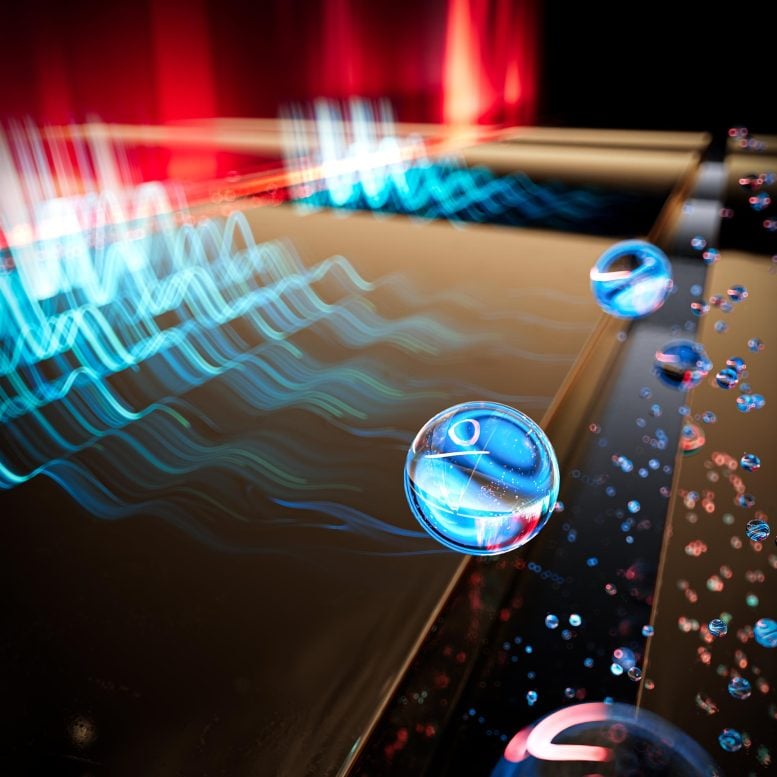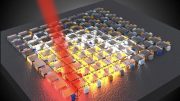
LSU researchers have made a significant discovery related to the fundamental properties and behavior of plasmonic waves, which can lead ot the development of more sensitive and robust quantum technologies. Credit: LSU
Quantum researchers uncover important implications for quantum technology.
In a recent publication in Nature Physics, the LSU Quantum Photonics Group offers fresh insights into the fundamental traits of surface plasmons, challenging the existing understanding. Based on experimental and theoretical investigations conducted in Associate Professor Omar Magaña-Loaiza’s laboratory, these novel findings mark a significant advancement in quantum plasmonics, possibly the most noteworthy in the past decade.
Rethinking Plasmonic Behavior
While prior research in the field has predominantly focused on the collective behaviors of plasmonic systems, the LSU group adopted a distinct approach. By viewing plasmonic waves as a puzzle, they were able to isolate multiparticle subsystems, or break down the puzzle into pieces. This allowed the team to see how different pieces work together and revealed a different picture, or in this case, new behaviors for surface plasmons.
Plasmons are waves that move along the surface of metals when light is coupled to charge oscillations. Much like tossing pebbles into water generates ripples, plasmons are “ripples” traveling along metal surfaces. These minute waves operate on a nanometer scale, rendering them crucial in fields such as nanotechnology and optics.
Quantum Mechanics of Plasmons
“What we found is that if we look at the quantum subsystems of plasmonic waves, we can see inverse patterns, sharper patterns, and opposite interference, which is completely opposite to the classical behavior,” explained Riley Dawkins, a graduate student and co-first author of the study, who led the theoretical investigation.
Using light aimed at a gold nanostructure and observing the behavior of scattered light, the LSU quantum group observed that surface plasmons can exhibit characteristics of both bosons and fermions, which are fundamental particles in quantum physics. This means that quantum subsystems can exhibit non-classical behaviors, such as moving in different directions, depending on specific conditions.
Implications for Quantum Technologies
“Imagine you are riding a bike. You would believe that most of your atoms are moving in the same direction as the bike. And that is true for most of them. But in fact, there are some atoms moving in the opposite direction,” explained Magaña-Loaiza. “One of the consequences of these results is that by understanding these very fundamental properties of plasmonic waves, and most importantly, this new behavior, one can develop more sensitive and robust quantum technologies.”
In 2007, the use of plasmonic waves for anthrax detection sparked research into employing quantum principles for improved sensor technology. Presently, researchers are striving to integrate these principles into plasmonic systems to create sensors with heightened sensitivity and precision. This advancement holds significant promise across diverse fields, including medical diagnostics, drug development simulations, environmental monitoring, and quantum information science.
A Milestone in Quantum Research
The study is poised to make a significant impact on the field of quantum plasmonics, as researchers worldwide will leverage the findings for quantum simulations. Chenglong You, Assistant Research Professor and corresponding author, emphasized, “Our findings not only unveil this interesting new behavior in quantum systems, but it is also the quantum plasmonic system with the largest-ever number of particles, and that alone elevates quantum physics to another level.”
Graduate student and co-first author Mingyuan Hong led the experimental phase of the study. Despite the complexities of quantum plasmonics systems, Hong noted that his primary challenges during the experiments were external disturbances. “The vibrations from various sources, such as road construction, posed a significant challenge due to the extreme sensitivity of the plasmic sample. Nevertheless, we eventually succeeded in extracting quantum properties from plasmonic waves, a breakthrough that enhances sensitive quantum technologies. This achievement could open up new possibilities for future quantum simulations.”
Titled “Nonclassical Near-Field Dynamics of Surface Plasmons,” the research was conducted entirely at LSU. “All the authors of this study are affiliated with LSU Physics & Astronomy. We even have a co-author who was a high school student at the time, which I’m very proud of,” said Magaña-Loaiza.
The illustration to the left shows a red laser beam exciting plasmonic waves on the surface of a metallic (gold) nanostructure. These are then scattered by the slit to produce multiparticle systems with specific quantum properties. These multiparticle systems are indicated by the spheres. Our manuscript describes the quantum dynamics behind this process.
This new research is prefaced by “Observation of the Modification of Quantum Statistics of Plasmonic Systems” in Nature Communications.
References:
“Nonclassical near-field dynamics of surface plasmons” by Mingyuan Hong, Riley B. Dawkins, Benjamin Bertoni, Chenglong You and Omar S. Magaña-Loaiza, 29 February 2024, Nature Physics.
DOI: 10.1038/s41567-024-02426-y
“Observation of the modification of quantum statistics of plasmonic systems” by Chenglong You, Mingyuan Hong, Narayan Bhusal, Jinnan Chen, Mario A. Quiroz-Juárez, Joshua Fabre, Fatemeh Mostafavi, Junpeng Guo, Israel De Leon, Roberto de J. León-Montiel and Omar S. Magaña-Loaiza, 27 August 2021, Nature Communications.
DOI: 10.1038/s41467-021-25489-4
The Quantum Photonics Group in the Department of Physics and Astronomy at LSU investigates novel properties of light and their potential for developing quantum technologies. The team also conducts experimental research in the fields of quantum plasmonics, quantum imaging, quantum metrology, quantum simulation, quantum communication, and quantum cryptography.









By viewing plasmonic waves as a puzzle, they were able to isolate multiparticle subsystems, or break down the puzzle into pieces.
Please answer:
1. What is the physical essence of plasma?
2. What is the physical reality of quantum mechanics?
3. Is the result the same when observing the same thing using different methods and perspectives?
and so on.
The universe does not do algebra, formula or fraction, the universe is geometry.
The branch of geometry (mathematics) known as topology has become a cornerstone of modern physics. Topological vortex and antivortex are two bidirectional coupled continuous chaotic systems. They exhibit parity conservation, charge conjugation, and time reversal symmetry. The synchronization effect is extremely important in their interactions. The synchronization effect of the superposition, deflection, and twisting of multiple or countless topological vortices will make spacetime motion more complex. To understand this complex world, physics should respect the authenticity of topological vortex in low dimensional spacetime, rather than simply relying on a few formulas, numbers, or imagined particles.
Spin is a natural property of topological vortices. The perpetually swirling topological vortices defy traditional physics’ expectations. Spin is synchronized with energy, spin is synchronized with gravitation, spin is synchronized with time, spin is synchronized with evolution. Please answer:
What is the difference between topological vortices and perpetual motion machines?
Today, we have already entered the era of the internet. With the help of artificial intelligence and big data, discussions on scientific knowledge have become open and transparent. However, a group of editors of so-called academic journals (such as Physical Review Letters, Nature, Science, etc.) are self-righteous and mystifying themselves. They only care about their own so-called sufficiently high priority rating, general significance, discipline, novelty, etc., and do not care about what science and pseudoscience are.
Science and pseudoscience are not determined by a publication, an organization or a person, nor by you or me, but by mathematics the final say. Physical models must be based on mathematics or mathematical models in order to be scientific, convincing, and in accordance with natural laws.
The branch of mathematics known as topology has become a cornerstone of modern physics. The perpetually swirling topological vortices defy traditional physics’ expectations. A physical properties of topological vortices is their to spontaneously begin to change periodically in time, even though the system does not experience corresponding periodic interference. Therefore, in the interaction of topological vortices, time is both absolute and relative,and physics often requires treating space and time at the same level.
Low-dimensional spacetime matter is the foundation of high-dimensional spacetime matter. Low-dimensional spacetime matter (such as topological vortex) can form new material structures and derive more complex physical properties via interactions and self-organization. It is extremely wrong and irresponsible to imagine low dimensional spacetime matter using high-dimensional spacetime matter.
Science must follow mathematical rules. For example, the Standard Model (SM) is considered to be one of the most significant achievements of physics in the 20th century. However, the magnetic moment of μ particle is larger than expected, revealed by a g-2 experiment at Fermilab, suggests that the established theory (such as SM) of fundamental particles is incomplete. Furthermore, the SM omitting gravitation, it not involved the time problem and when the particle movement starts. Mathematics is the foundation of science. Physics must respect the scientific nature of mathematics and mathematical models. The SM must be based on mathematical models in order to be scientific, convincing, and in line with natural laws.
I hope researchers are not fooled by the pseudoscientific theories of the Physical Review Letters (PRL), and hope more people dare to stand up and fight against rampant pseudoscience.
The so-called academic journals (such as Physical Review Letters, Nature, Science, etc.) firmly believe that two high-dimensional spacetime objects (such as two sets of cobalt-60) rotating in opposite directions can be transformed into two objects that mirror each other, is a typical case of pseudoscience rampant.
If researchers are really interested in Science and Physics, you can browse https://zhuanlan.zhihu.com/p/643404671 and https://zhuanlan.zhihu.com/p/595280873.